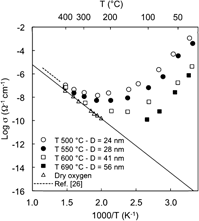Crossref Citations
This article has been cited by the following publications. This list is generated based on data provided by
Crossref.
Gregori, Giuliano
Shirpour, Mona
and
Maier, Joachim
2013.
Proton Conduction in Dense and Porous Nanocrystalline Ceria Thin Films.
Advanced Functional Materials,
Vol. 23,
Issue. 47,
p.
5861.
Maglia, Filippo
Tredici, Ilenia G.
and
Anselmi-Tamburini, Umberto
2013.
Densification and properties of bulk nanocrystalline functional ceramics with grain size below 50nm.
Journal of the European Ceramic Society,
Vol. 33,
Issue. 6,
p.
1045.
Tredici, Ilenia G.
Maglia, Filippo
Ferrara, Chiara
Mustarelli, Piercarlo
and
Anselmi‐Tamburini, Umberto
2014.
Mechanism of Low‐Temperature Protonic Conductivity in Bulk, High‐Density, Nanometric Titanium Oxide.
Advanced Functional Materials,
Vol. 24,
Issue. 32,
p.
5137.
Pranevicius, L.
Pranevicius, L.L.
Vilkinis, P.
Baltaragis, S.
and
Gedvilas, K.
2014.
Water surface coverage effects on reactivity of plasma oxidized Ti films.
Applied Surface Science,
Vol. 295,
Issue. ,
p.
240.
Clark, D.
Tong, J.
Morrissey, A.
Almansoori, A.
Reimanis, I.
and
O'Hayre, R.
2014.
Anomalous low-temperature proton conductivity enhancement in a novel protonic nanocomposite.
Phys. Chem. Chem. Phys.,
Vol. 16,
Issue. 11,
p.
5076.
Knauth, Philippe
Saltsburg, Howard
Engel, Johanna
and
Tuller, Harry L.
2015.
In situ dilatometric and impedance spectroscopic study of core–shell like structures: insights into the exceptional catalytic activity of nanocrystalline Cu-doped CeO2.
Journal of Materials Chemistry A,
Vol. 3,
Issue. 16,
p.
8369.
Knauth, P.
Engel, J.
Bishop, S. R.
and
Tuller, H. L.
2015.
Study of compaction and sintering of nanosized oxide powders by in situ electrical measurements and dilatometry: Nano CeO2—case study.
Journal of Electroceramics,
Vol. 34,
Issue. 1,
p.
82.
Stub, Sindre Østby
Vøllestad, Einar
and
Norby, Truls
2017.
Mechanisms of Protonic Surface Transport in Porous Oxides: Example of YSZ.
The Journal of Physical Chemistry C,
Vol. 121,
Issue. 23,
p.
12817.
Gregori, Giuliano
Merkle, Rotraut
and
Maier, Joachim
2017.
Ion conduction and redistribution at grain boundaries in oxide systems.
Progress in Materials Science,
Vol. 89,
Issue. ,
p.
252.
Anselmi-Tamburini, U.
and
Groza, J. R.
2017.
Critical assessment 28: Electrical field/current application – a revolution in materials processing/sintering?.
Materials Science and Technology,
Vol. 33,
Issue. 16,
p.
1855.
Stub, Sindre Ø.
Vøllestad, Einar
and
Norby, Truls
2018.
Protonic surface conduction controlled by space charge of intersecting grain boundaries in porous ceramics.
Journal of Materials Chemistry A,
Vol. 6,
Issue. 18,
p.
8265.
Stub, Sindre Østby
Thorshaug, Knut
Rørvik, Per Martin
Norby, Truls
and
Vøllestad, Einar
2018.
The influence of acceptor and donor doping on the protonic surface conduction of TiO2.
Physical Chemistry Chemical Physics,
Vol. 20,
Issue. 23,
p.
15653.
Runnerstrom, Evan L.
Ong, Gary K.
Gregori, Giuliano
Maier, Joachim
and
Milliron, Delia J.
2018.
Colloidal Nanocrystal Films Reveal the Mechanism for Intermediate Temperature Proton Conductivity in Porous Ceramics.
The Journal of Physical Chemistry C,
Vol. 122,
Issue. 25,
p.
13624.
2018.
7.酸化物表面プロトニクス:表面プロトン活性とその輸送機構.
Denki Kagaku,
Vol. 86,
Issue. Spring,
p.
35.
Meng, Yuqing
Gao, Jun
Zhao, Zeyu
Amoroso, Jake
Tong, Jianhua
and
Brinkman, Kyle S.
2019.
Review: recent progress in low-temperature proton-conducting ceramics.
Journal of Materials Science,
Vol. 54,
Issue. 13,
p.
9291.
Torimoto, Maki
Ogo, Shuhei
Hisai, Yudai
Nakano, Naoya
Takahashi, Ayako
Ma, Quanbao
Seo, Jeong Gil
Tsuneki, Hideaki
Norby, Truls
and
Sekine, Yasushi
2020.
Support effects on catalysis of low temperature methane steam reforming.
RSC Advances,
Vol. 10,
Issue. 44,
p.
26418.
Gao, Jun
Meng, Yuqing
Benton, Allen
He, Jian
Jacobsohn, Luiz G.
Tong, Jianhua
and
Brinkman, Kyle S.
2020.
Insights into the Proton Transport Mechanism in TiO2 Simple Oxides by In Situ Raman Spectroscopy.
ACS Applied Materials & Interfaces,
Vol. 12,
Issue. 34,
p.
38012.
Takahashi, Ayako
Inagaki, Reona
Torimoto, Maki
Hisai, Yudai
Matsuda, Taku
Ma, Quanbao
Seo, Jeong Gil
Higo, Takuma
Tsuneki, Hideaki
Ogo, Shuhei
Norby, Truls
and
Sekine, Yasushi
2020.
Effects of metal cation doping in CeO2 support on catalytic methane steam reforming at low temperature in an electric field.
RSC Advances,
Vol. 10,
Issue. 25,
p.
14487.
Celik, Erdogan
Negi, Rajendra S.
Bastianello, Michele
Boll, Dominic
Mazilkin, Andrey
Brezesinski, Torsten
and
Elm, Matthias T.
2020.
Tailoring the protonic conductivity of porous yttria-stabilized zirconia thin films by surface modification.
Physical Chemistry Chemical Physics,
Vol. 22,
Issue. 20,
p.
11519.
Simons, Philipp
Torres, Kierstin P.
and
Rupp, Jennifer L. M.
2021.
Careful Choices in Low Temperature Ceramic Processing and Slow Hydration Kinetics Can Affect Proton Conduction in Ceria.
Advanced Functional Materials,
Vol. 31,
Issue. 31,



